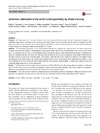Please use this identifier to cite or link to this item:
https://accedacris.ulpgc.es/jspui/handle/10553/43472
| Title: | Automatic estimation of the aortic lumen geometry by ellipse tracking | Authors: | Tahoces, Pablo G. Alvarez, Luis González Sánchez, Esther Cuenca Hernández, Carmelo Trujillo Pino, Agustín Rafael Santana-Cedrés, Daniel Esclarín Monreal, Julio Gómez Déniz, Luis Mazorra Manrique de Lara, Luis Alemán-Flores, Miguel Carreira, José M. |
UNESCO Clasification: | 220990 Tratamiento digital. Imágenes | Keywords: | Aorta Ellipse tracking Centerline Cross section CT images |
Issue Date: | 2019 | Publisher: | 1861-6410 | Project: | Nuevos Modelos Matemáticos Para la Segmentación y Clasificación en Imágenes | Journal: | Computer-Assisted Radiology and Surgery | Abstract: | Purpose: The shape and size of the aortic lumen can be associated with several aortic diseases. Automated computer segmentation can provide a mechanism for extracting the main features of the aorta that may be used as a diagnostic aid for physicians. This article presents a new fully automated algorithm to extract the aorta geometry for either normal (with and without contrast) or abnormal computed tomography (CT) cases. Methods: The algorithm we propose is a fast incremental technique that computes the 3D geometry of the aortic lumen from an initial contour located inside it. Our approach is based on the optimization of the 3D orientation of the cross sections of the aorta. The method uses a robust ellipse estimation algorithm and an energy-based optimization technique to automatically track the centerline and the cross sections. The optimization involves the size and eccentricity of the ellipse which best fits the aorta contour on each cross-sectional plane. The method works directly on the original CT and does not require a prior segmentation of the aortic lumen. We present experimental results to show the accuracy of the method and its ability to cope with challenging CT cases where the aortic lumen may have low contrast, different kinds of pathologies, artifacts, and even significant angulations due to severe elongations. Results: The algorithm correctly tracked the aorta geometry in 380 of 385 CT cases. The mean of the dice similarity coefficient was 0.951 for aorta cross sections that were randomly selected from the whole database. The mean distance to a manually delineated segmentation of the aortic lumen was 0.9 mm for sixteen selected cases. Conclusions: The results achieved after the evaluation demonstrate that the proposed algorithm is robust and accurate for the automatic extraction of the aorta geometry for both normal (with and without contrast) and abnormal CT volumes. | URI: | https://accedacris.ulpgc.es/handle/10553/43472 | ISSN: | 1861-6410 | DOI: | 10.1007/s11548-018-1861-0 | Source: | International Journal Of Computer Assisted Radiology And Surgery [ISSN 1861-6410], v. 14 (2), p. 345-355 |
| Appears in Collections: | Artículos |
SCOPUSTM
Citations
15
checked on Jun 8, 2025
WEB OF SCIENCETM
Citations
13
checked on Jun 8, 2025
Page view(s)
219
checked on Jun 15, 2024
Download(s)
314
checked on Jun 15, 2024
Google ScholarTM
Check
Altmetric
Share
Export metadata
Items in accedaCRIS are protected by copyright, with all rights reserved, unless otherwise indicated.
